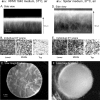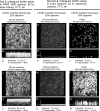Impact of environmental conditions on the form and function of Candida albicans biofilms
- PMID: 23954841
- PMCID: PMC3811334
- DOI: 10.1128/EC.00127-13
Impact of environmental conditions on the form and function of Candida albicans biofilms
Abstract
Candida albicans, like other pathogens, can form complex biofilms on a variety of substrates. However, as the number of studies of gene regulation, architecture, and pathogenic traits of C. albicans biofilms has increased, so have differences in results. This suggests that depending upon the conditions employed, biofilms may vary widely, thus hampering attempts at a uniform description. Gene expression studies suggest that this may be the case. To explore this hypothesis further, we compared the architectures and traits of biofilms formed in RPMI 1640 and Spider media at 37°C in air. Biofilms formed by a/α cells in the two media differed to various degrees in cellular architecture, matrix deposition, penetrability by leukocytes, fluconazole susceptibility, and the facilitation of mating. Similar comparisons of a/a cells in the two media, however, were made difficult given that in air, although a/a cells form traditional biofilms in RPMI medium, they form polylayers composed primarily of yeast cells in Spider medium. These polylayers lack an upper hyphal/matrix region, are readily penetrated by leukocytes, are highly fluconazole susceptible, and do not facilitate mating. If, however, air is replaced with 20% CO2, a/a cells make a biofilm in Spider medium similar architecturally to that of a/α cells, which facilitates mating. A second, more cursory comparison is made between the disparate cellular architectures of a/a biofilms formed in air in RPMI and Lee's media. The results demonstrate that C. albicans forms very different types of biofilms depending upon the composition of the medium, level of CO2 in the atmosphere, and configuration of the MTL locus.
Figures







Similar articles
-
Candida albicans forms a specialized "sexual" as well as "pathogenic" biofilm.Eukaryot Cell. 2013 Aug;12(8):1120-31. doi: 10.1128/EC.00112-13. Epub 2013 Jun 14. Eukaryot Cell. 2013. PMID: 23771904 Free PMC article.
-
Detailed comparison of Candida albicans and Candida glabrata biofilms under different conditions and their susceptibility to caspofungin and anidulafungin.J Med Microbiol. 2011 Sep;60(Pt 9):1261-1269. doi: 10.1099/jmm.0.032037-0. Epub 2011 May 12. J Med Microbiol. 2011. PMID: 21566087
-
Biofilm matrix of Candida albicans and Candida tropicalis: chemical composition and role in drug resistance.J Med Microbiol. 2006 Aug;55(Pt 8):999-1008. doi: 10.1099/jmm.0.46569-0. J Med Microbiol. 2006. PMID: 16849719
-
Unraveling How Candida albicans Forms Sexual Biofilms.J Fungi (Basel). 2020 Jan 15;6(1):14. doi: 10.3390/jof6010014. J Fungi (Basel). 2020. PMID: 31952361 Free PMC article. Review.
-
Development and regulation of single- and multi-species Candida albicans biofilms.Nat Rev Microbiol. 2018 Jan;16(1):19-31. doi: 10.1038/nrmicro.2017.107. Epub 2017 Oct 3. Nat Rev Microbiol. 2018. PMID: 29062072 Free PMC article. Review.
Cited by
-
Filamentous Non-albicans Candida Species Adhere to Candida albicans and Benefit From Dual Biofilm Growth.Front Microbiol. 2019 May 31;10:1188. doi: 10.3389/fmicb.2019.01188. eCollection 2019. Front Microbiol. 2019. PMID: 31231324 Free PMC article.
-
Screening of Candida albicans GRACE library revealed a unique pattern of biofilm formation under repression of the essential gene ILS1.Sci Rep. 2019 Jun 24;9(1):9187. doi: 10.1038/s41598-019-45624-y. Sci Rep. 2019. PMID: 31235750 Free PMC article.
-
Disparate Candida albicans Biofilm Formation in Clinical Lipid Emulsions Due to Capric Acid-Mediated Inhibition.Antimicrob Agents Chemother. 2019 Oct 22;63(11):e01394-19. doi: 10.1128/AAC.01394-19. Print 2019 Nov. Antimicrob Agents Chemother. 2019. PMID: 31405860 Free PMC article.
-
The role of phenotypic switching in the basic biology and pathogenesis of Candida albicans.J Oral Microbiol. 2014 Jan 15;6. doi: 10.3402/jom.v6.22993. eCollection 2014 Jan 15. J Oral Microbiol. 2014. PMID: 24455104 Free PMC article. Review.
-
Candida albicans cell-type switching and functional plasticity in the mammalian host.Nat Rev Microbiol. 2017 Feb;15(2):96-108. doi: 10.1038/nrmicro.2016.157. Epub 2016 Nov 21. Nat Rev Microbiol. 2017. PMID: 27867199 Free PMC article. Review.
References
-
- Costerton JW, Stewart PS, Greenberg EP. 1999. Bacterial biofilms: a common cause of persistent infections. Science 284:1318–1322 - PubMed
-
- Hall-Stoodley L, Stoodley P. 2005. Biofilm formation and dispersal and the transmission of human pathogens. Trends Microbiol. 13:7–10 - PubMed
-
- Douglas LJ. 2003. Candida biofilms and their role in infection. Trends Microbiol. 11:30–36 - PubMed
Publication types
MeSH terms
Substances
LinkOut - more resources
Full Text Sources
Other Literature Sources

